One of the most popular destinations in Tokyo is Meiji Jingu (明治神宮), built to honor Emperor Meiji who modernized Japan and open its door to the west.

Nestled in the heart of Tokyo’s busy Shibuya district is a landmark that you will not want to miss: the revered shrine to Emperor Meiji and Empress Shoken. From the moment you spot the massive wooden Torii gates, it is clear that a special place awaits.
Built to honor the emperor responsible for opening Japan’s doors to the West, the shrine honors Emperor Meiji and Empress Shoken. The shrine and surrounding park do a stunning job of paying homage to key figures in Japan’s history. Surrounded by meticulously planted forests that contain 365 different species of trees, this secluded forest, right in the city, is a wonderful place of refuge from Tokyo’s manic hustle and bustle.
Table of Contents
You might notice there are many areas/wards/stations we missed in Tokyo from the above list, like Tokyo Station. It’s because we simply ran out of time to cover and will add it in a future trip. If you have any specific requests, please comment below and we’ll try to add it to our future itineraries.
Getting There and What to Expect
If you investigate tours in Tokyo, you will find that Meiji Jingu is almost on every itinerary. The shrine is conveniently located just a 15 – 20-minute walk from Shinjuku and Shibuya Stations. There is also an entrance near the Harajuku Station (Tokyo Metro Chiyoda, Fukutoshin lines).
After visiting bustling Shinjuku, it’s time to find some peace and green forestry in Tokyo. Meiji Jingu is a large park within Tokyo; the inner and outer parks cover over 1,000,000 square meters (~245 acres) and have 170,000 trees.

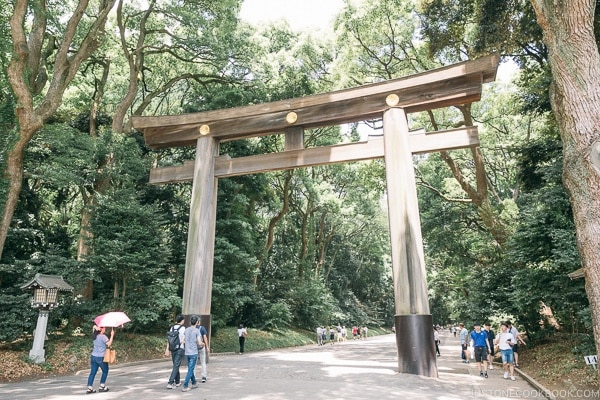
When you get to Meiji Jingu and after crossing the Jingu Bridge, you’ll get to the first of the 3 Torii Gates towering over the walking path. The path into the shrine is really wide compared to other Japanese shrines.

The main gate, known as the Ootori Gate, is the largest wooden gate of its type. It dominates the entrance, standing an impressive 12 meters/39 feet tall and 17.1 meters/55 feet wide.
Once you pass through the first Torii gate, you’ll see Meiji Jingu Inner Garden on your left. The garden has been there since the 1600s, and it is the only part of the Meiji Shrine that requires a fee (500 yen).
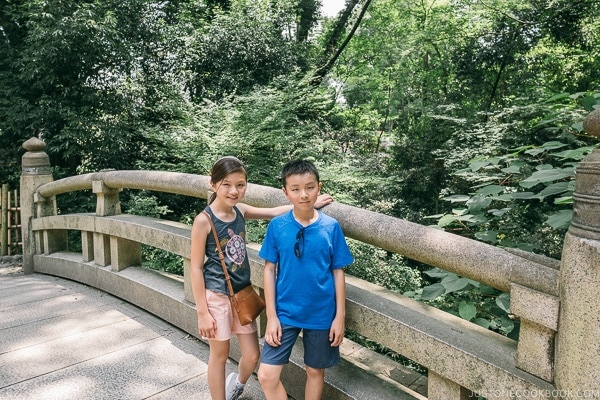
Meiji Jingu Inner Garden 明治神宮御苑
The shrine’s inner garden is said to have been commissioned by Emperor Meiji for his wife. It is considered a place of deep spiritual energy. The artfully sculpted grounds exude a calming presence and breathtaking beauty, so it is not hard to imagine gaining a positive energy boost by spending time wandering among the flowers and trees. After visiting the inner garden, continue on the large path towards the main shrine.


History
A little bit of sorcery is at play within the grounds of the shrine. This is because the shrine is not technically as old as it seems. While the grounds are indeed steeped with thousands of years of history, the original structures of the shrine were only built in 1920. Like many sites in Tokyo, the original main shrine building was destroyed by WW2 bombing. With tremendous public support, a new shrine was soon rebuilt. The shrine’s setting is in an ancient garden, an urban oasis best known for its prolific irises.
The garden was often visited by Emperor Meiji and Empress Shoken as they loved this tranquil sanctuary within Tokyo. The garden consists of seasonal flowers and plants, a large pond, and a traditional teahouse.


Top Reasons to Visit Meiji Jingu Shrine
- Besides gaining an insight into an important part of Japan’s history, the park and shrine combine to create a place of stunning beauty and calming energy. It is easy to get caught up in the hustle and bustle of Tokyo, and the Meiji Shrine is an excellent place to find peace and tranquility.
- As a key place of worship for the Shinto religion, the main hall in the shrine complex introduces visitors to this centuries-old religion. English-language signage makes it easy for first-time practitioners to experience the cleansing Shinto rituals or sit peacefully and observe Shinto worshipers paying homage through offerings or prayers.
- Observe the daily rituals of the Meiji Jingu, Shinto devotees, as they place food offerings to the Kami. The shrine is also a popular spot for weddings, so if visitors are lucky, they may be able to witness a traditional Shinto wedding.
- Festivals and events are held here throughout the year, with key festivals honoring the changing of each season. The grand festival, held on November 3rd to honor the emperor’s birthday, is one of the biggest events hosted. Smaller venues are also held throughout the year. Sometimes, these events are kept discreet, so it is worth checking to see what events might happen when you are in Tokyo.
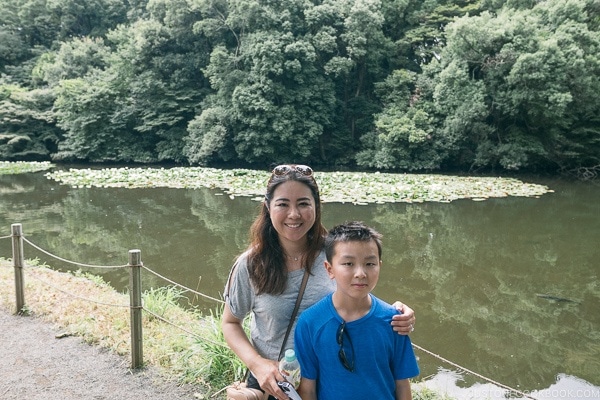

When we visited in July, the iris garden just finished blooming, so it was a lush, vibrant green.




The Well of Kiyomasa is said to have particularly strong energy, bringing good fortune to those who stop and honor this quiet space.

After visiting the inner garden, continue on the large path towards the main shrine.

You will soon arrive at the sake offered annually to the deities and wine barrels to be consecrated. Why the wine barrels? Emperor Meiji led the example for modernization by enjoying Western culture, food, and wine.
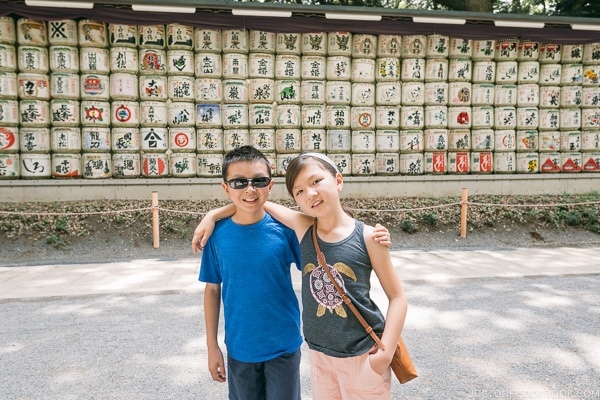


As you proceed along the path, you see the second Torii gate towering an impressive 12 meters high. It is made of Hinoki wood from Taiwan.


Walk a bit further, and you’ll come upon the third Torii gate and the main shrine building. For those who are not familiar with the distinction between shrines and temples in Japan, shrines are for the Shinto religion, and temples are for Buddhism.

Things to Know
Meiji Jingu Shrine and the surrounding park are open from sunrise to sunset. They are billed as being excellent to visit year-round, but June and July are especially popular times to visit. New Year is also spectacular in the park, as there are typically special events planned.


The Meiji Jingu Museum
In 2019, a museum was added to the grounds. The Meiji Jingu Museum offers the history of both the emperor and the surrounding grounds. In addition to the museum, one other spot which showcases historical artifacts.
The Homotsuden, Meiji Jingu Treasure House
True to its name, the Treasure House contains historical artifacts and the personal artifacts of the emperor and his wife. Built in 1921, the Treasure Museum is one of the original buildings in the park.

The copper roof on the buildings that make up the Shinto shrine is an impressive crown to the intricately constructed building. The wood chosen for the building is Japanese cypress, and the wood is perfectly accentuated by its copper shielding.






In the large courtyard, you’ll find a few large camphor trees. You can purchase wooden plaques, write your wishes on them, and pray to the deities.


A Note on Traditions and Customs
The current shrine buildings were built in 1958 as the original ones were destroyed during the war. When you pray in a Shinto shrine, here is the correct process:
- Put some coins into the offertory box.
- Bow twice.
- Clap your hands twice.
- Make a wish if you like.
- Bow once again.



Nearby Sites
If you visit Meiji Jingu Shrine, you are in for another treat: nearby Yoyogi Park. This park alone makes the stop on the grounds of the Meiji Shrine worthwhile. Situated immediately adjacent to the Meiji Shrine, Yoyogi Park is the fifth largest park in Tokyo. The wide expanses of green lawns are interspersed with fountains and trees, making the area a prime picnic location.
After visiting the Shrine and taking in the tranquility of the forest in this city environment, it’s time to head to the fashion and culture headquarters of Japan, Harajuku, and Omotesando.
For more Japanese travel guides, click here, and to read the Tokyo travel guide, click here.
Check out our other Tokyo travel guide series:
- Shinjuku 新宿
- Meiji Jingu 明治神宮
- Harajuku and Omotesando 原宿・表参道
- Shibuya 渋谷
- Roppongi 六本木ヒルズ
- Tokyo Tower (update) 東京タワー
- Ginza 銀座
- Imperial East Garden 皇居東御苑
- Akihabara 秋葉原
- Ueno 上野
- Kappabashi かっぱ橋道具街
- Tokyo Dome City 東京ドームシティー
- Asakusa (update) 浅草
- Tokyo Sky Tree (update) 東京スカイツリー
- Odaiba お台場

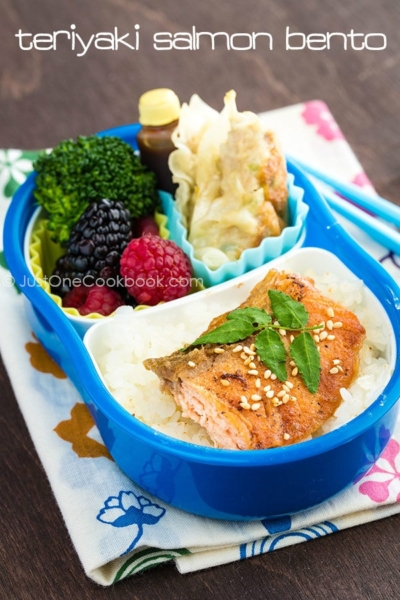







Thanks for the Meiji Jingu Gardens photos and information will be on our list next February when we visit.
Hi Terry,
Thank you for reading our Tokyo series. Let us know if you have any questions before your visit.
Cheers
MR. JOC